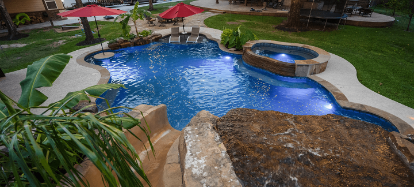If your pool or pool equipment has been flooded/submerged by stormwater, sewage water, or any other possible contaminants, please see our recommended startup list.
Get Started On Your
Backyard Oasis Today
Schedule Your Free Consultation
Recommended Startup List
1. DO NOT DRAIN YOUR POOL: "Pool pop-up phenomenon" is always a possibility especially right after a severe storm and or flood. The soil conditions surrounding your pool are saturated and expanded putting upward pressure on your pool shell.
2. If your pool is on a weekly maintenance program with a pool professional, contact them to see what their schedule is and what recommendations they have for your specific pool. Discuss the items in this checklist with them.
3. Try to clean as much debris out of your pools as possible. Next, clean the skimmers, main drains, robot cleaner bags, and pump baskets.
4. Go to your pool equipment and turn off all your breakers, then go to your home breaker box and reset your pool breakers that may have tripped. If the breaker won't reset, call an electrician or a pool service company. If your main breaker resets, go to your pool equipment breaker box and slowly one by one reset your equipment breakers and see if the equipment is working. (If your equipment was running during the storm it may have sucked up a tremendous amount of mud and debris and burned out.) If the breakers come on and equipment starts up, monitor the water to make sure it starts flowing through the pumps.
5. Check the pressure gauge on your filters. If it is close to or over 30 psi, turn off your equipment and clean your filters. The pump probably sucked up a lot of debris before the equipment went off. Note the pressure when you restart the pool. After cleaning, the filters should be much lower.
6. Get pool Shock from your local pool supply store. The Standard pool dose is 1# of Dichlor-Shock per 10,000 gallons of water. Due to the heavy possible contaminates we recommend that you double that dose. Do not swim in the pool for at least 48 hours; not that you would want to at this point.
7. Run your pool equipment for 24 hours a day until the water returns to its normal clear state. Continue to monitor the pressure in the filter. If it gets to 30 psi again clean or backwash your filter.
8. Brush the pool two to three times every day to keep dirt stirred up so it can make it to the pool filter.
9. Even though you might not be able to see the bottom of the pool vacuum the pool every day. Note: You will most likely have to backwash sand and DE filters each time you do this or clean the cartridges.
10. If you cannot make any positive changes on your pool after trying to get it clean please contact your local pool builder or service company to get on their list to drain and clean if necessary under controlled supervision. If the pool clears up with the above procedures you can always cancel but most companies are many weeks behind so it is best to get on their schedule now.
11. WATER QUALITY SAFETY: Chlorine is a powerful sanitizer. However, organisms like cryptosporidium and E-Coli can be resistant to chlorine and can be dangerous to your family's health. If there is any chance that the floodwater has been in contact with dead animals (from a reservoir or field, for example), any chance that sewage entered your pool, or if you just want that extra peace of mind, we recommend dosing with additional pool products like Sea Klear PRS (stages 1 and 2) on startup. These products can help trap germs in the filter, or if you are suspicious of the floodwater, there are bacteria test strips you can get online or from local pool supply stores just for that extra peace of mind.
Once the cleaning process starts, we will need to balance the water again
1. Clean or backwash filters. Note pressure when starting back up after cleaning.
2. Take the water sample to your local pool supply store or Immediately check water chemistry using your test kit or strips. They will tell you what you need to adjust Total Alkalinity and PH as required before adding any other chemicals.
3. Fill chlorine tablet feeder if installed on your pool.
4. Shock the pool using Dichlor at the rate of 1# per 10,00 gallons of water
5. With the soft rainwater, you are more than like going to need to check your water hardness and add some calcium back to the pool to prevent damage to the pool plaster.
6. With the diluted pool water, you're going to probably need to add chlorine stabilizer to the pool as well, so don't think the stores are just trying to sell your unwanted products.
7. Continue to monitor pressure on the filter and clean or backwash each time the pressure gets 10# higher than the normal pool pressure.
Good luck and safe swimming
*This list is a suggested list of steps to help you with your swimming pool. However, it is not an all-encompassing list as every pool or situation is different. Following these suggestions is something you choose to do of your own free will, and you agree to hold any posting entity harmless from any damages.
Proud of Our Partners & Accreditations









